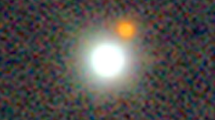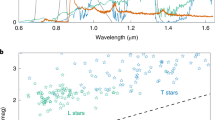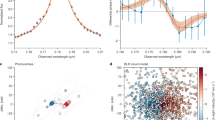Abstract
THE primordial ratio of deuterium to hydrogen nuclei (D/H), created as a result of the Big Bang, provides the most sensitive measure of the cosmological density of baryons1–5. Measurements of the D/H ratio in the interstellar medium of our Galaxy place a strict lower limit on the primordial ratio6, because processing of gas by stars reduces the abundance of deuterium relative to hydrogen. Absorption of radiation from distant quasars by intervening clouds of gas offers a means of probing D/H ratios at large redshifts, where the effects of stellar processing should be negligible. Measurements7,8 on one absorption system have indicated an extremely high primordial abundance ratio of 24 × 10–5. Here we report a measurement of the D/H ratio in another high-redshift absorption system, and obtain a value that is an order of magnitude lower than that reported previously7,8. The measured ratio of 2.3 × 10–5 is consistent with that in the interstellar medium (after allowing for Galactic chemical evolution9,10), and indicates that the absorption spectra on which the earlier estimates are based may have been subject to strong contamination. We calculate a baryon density that is 5% of the critical density required to close the Universe.
This is a preview of subscription content, access via your institution
Access options
Subscribe to this journal
Receive 51 print issues and online access
$199.00 per year
only $3.90 per issue
Buy this article
- Purchase on Springer Link
- Instant access to full article PDF
Prices may be subject to local taxes which are calculated during checkout
Similar content being viewed by others
References
Walker, T. P., Steigman, G., Schramm, D. N., Olive, K. A. & Kang, H. S. Astrophys. J. 376, 51–69 (1991).
Smith, M. S., Kawano, L. H. & Malaney, R. A. Astrophys. J. Suppl. Ser. 85, 219–247 (1993).
Krauss, L. M. & Kernan, P. J. Phys. Lett. B347, 347–353 (1995).
Sarkar, S. Rep. Prog. Phys. (submitted).
Copi, C. J., Schramm, D. N. & Turner, M. S. Science 267, 192–199 (1995).
Linsky, J. L. et al. Astrophys. J. 451, 335–351 (1995).
Songaila, A., Cowie, L. L., Hogan, C. J. & Rugers, M. Nature 368, 599–603 (1994).
Carswell, R. F., Rauch, M., Weymann, R. J., Cooke, A. J. & Webb, J. K. Mon. Not. R. astr. Soc. 268, L1–L4 (1994).
Edmunds, M. G. Mon. Not. R. astr. Soc. 270, L37–L41 (1994).
Steigman, G. & Tosi, M. Astrophys. J. 453, 173–177 (1995).
Petitjean, P. & Bergeron, J. Astr. Astrophys. 231, 309–326 (1990).
Vogt, S. S. et al. Proc. SPIE 2198, 362–375 (1994).
Hu, E. M., Kim, T. S., Cowie, L. L. & Songaila, A. Astr. J. 110, 1526–1543 (1995).
Donahue, M. & Shull, J. M. Astrophys. J. 383, 511–523 (1991).
Mathews, W. D. & Ferland, G. Astrophys. J. 323, 456–467 (1987).
Steigman, G. & Tosi, M. Astrophys. J. 401, 150–156 (1992).
Wampler, E. J. et al. Astr. Astrophys. (submitted).
Carswell, R. F. et al. Mon. Not. R. astr. Soc. 278, 506–518 (1996).
McCullough, P. R. Astrophys. J. 390, 213–218 (1992).
Galli, D., Palla, F., Ferrini, F. & Penco, U. Astrophys. J. 443, 536–550 (1995).
Geiss, J. in Origin and Evolution of the Elements (eds Prantzos, N., Vangioni-Flam, E. & Cassé, M.) 89 (Cambridge Univ. Press, 1994).
Persic, M. & Salucci, P. Mon. Not. R. astr. Soc. 258, 14–18 (1992).
Pratt, M. et al. (MACHO collaboration) Workshop on Dark Matter in the Universe Santa Monica, February (1996).
Jakobsen, P. et al. Nature 370, 35–39 (1994).
Pagel, B. E. J., Simonson, E. A., Terlevich, R. J. & Edmunds, M. G. Mon. Not. R. astr. Soc. 255, 325–345 (1992).
Thuan, T. X., Izotov, Y. I. & Lipovetsky, V. A. in Interplay between Massive Star formation, the ISM and Galaxy Evolution (eds Kunth, D., Guiderdoni, B., Heydari-Malayeri, M. & Thuan, T. X.) (Editions Frontieres Gif-sur-Yvette, 1996).
Sasselov, D. & Goldwirth, D. Astrophys. J. 444, L5–L8 (1995).
Pagel, B. E. J. in ESO/EIPC Workshop on Light Elements (ed. Crane, P.) 155–164 (Springer, Berlin, 1994).
Vauclaire, S. & Charbonnel, C. Astr. Astrophys. 295, 715–724 (1995).
Charbonnel, C. Astrophys. J. 453, L41–L44 (1995).
Ryan, S. G., Beers, T. C., Deliyannis, C. P. & Thorburn, J. A. Astrophys. J. 458, 543–560 (1996).
Morton, D. C. Astrophys. J. Suppl. Ser. 77, 119–202 (1991).
Levshakov, S. A. & Kegel, W. H. Mon. Not. R. astr. Soc. 278, 497–505 (1996).
Gail, H. P., Hundt, E., Kegel, W. H., Schmid-Burgk, J. & Traving, G. Astr. Astrophys. 32, 65–72 (1974).
Author information
Authors and Affiliations
Rights and permissions
About this article
Cite this article
Tytler, D., Fan, XM. & Burles, S. Cosmological baryon density derived from the deuterium abundance at redshift z = 3.57. Nature 381, 207–209 (1996). https://doi.org/10.1038/381207a0
Received:
Accepted:
Issue Date:
DOI: https://doi.org/10.1038/381207a0
This article is cited by
-
New measurements of cross sections and S-factors for \(d(p,\gamma )^{3}\text{He}\) reaction at BBN energies
Journal of Astrophysics and Astronomy (2020)
Comments
By submitting a comment you agree to abide by our Terms and Community Guidelines. If you find something abusive or that does not comply with our terms or guidelines please flag it as inappropriate.



